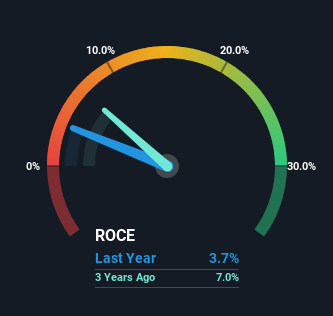- South Korea
- /
- Aerospace & Defense
- /
- KOSE:A272210
Hanwha Systems' (KRX:272210) Returns On Capital Not Reflecting Well On The Business

If you're looking for a multi-bagger, there's a few things to keep an eye out for. In a perfect world, we'd like to see a company investing more capital into its business and ideally the returns earned from that capital are also increasing. If you see this, it typically means it's a company with a great business model and plenty of profitable reinvestment opportunities. However, after investigating Hanwha Systems (KRX:272210), we don't think it's current trends fit the mold of a multi-bagger.
Return On Capital Employed (ROCE): What Is It?
Just to clarify if you're unsure, ROCE is a metric for evaluating how much pre-tax income (in percentage terms) a company earns on the capital invested in its business. To calculate this metric for Hanwha Systems, this is the formula:
Return on Capital Employed = Earnings Before Interest and Tax (EBIT) ÷ (Total Assets - Current Liabilities)
0.037 = ₩93b ÷ (₩4.5t - ₩2.0t) (Based on the trailing twelve months to December 2023).
Therefore, Hanwha Systems has an ROCE of 3.7%. Ultimately, that's a low return and it under-performs the Aerospace & Defense industry average of 5.1%.
See our latest analysis for Hanwha Systems

Above you can see how the current ROCE for Hanwha Systems compares to its prior returns on capital, but there's only so much you can tell from the past. If you'd like to see what analysts are forecasting going forward, you should check out our free analyst report for Hanwha Systems .
How Are Returns Trending?
On the surface, the trend of ROCE at Hanwha Systems doesn't inspire confidence. Over the last four years, returns on capital have decreased to 3.7% from 6.9% four years ago. However, given capital employed and revenue have both increased it appears that the business is currently pursuing growth, at the consequence of short term returns. If these investments prove successful, this can bode very well for long term stock performance.
On a separate but related note, it's important to know that Hanwha Systems has a current liabilities to total assets ratio of 44%, which we'd consider pretty high. This effectively means that suppliers (or short-term creditors) are funding a large portion of the business, so just be aware that this can introduce some elements of risk. While it's not necessarily a bad thing, it can be beneficial if this ratio is lower.
The Bottom Line On Hanwha Systems' ROCE
In summary, despite lower returns in the short term, we're encouraged to see that Hanwha Systems is reinvesting for growth and has higher sales as a result. These trends don't appear to have influenced returns though, because the total return from the stock has been mostly flat over the last three years. So we think it'd be worthwhile to look further into this stock given the trends look encouraging.
Hanwha Systems does have some risks, we noticed 3 warning signs (and 2 which are concerning) we think you should know about.
While Hanwha Systems may not currently earn the highest returns, we've compiled a list of companies that currently earn more than 25% return on equity. Check out this free list here.
If you're looking to trade Hanwha Systems, open an account with the lowest-cost platform trusted by professionals, Interactive Brokers.
With clients in over 200 countries and territories, and access to 160 markets, IBKR lets you trade stocks, options, futures, forex, bonds and funds from a single integrated account.
Enjoy no hidden fees, no account minimums, and FX conversion rates as low as 0.03%, far better than what most brokers offer.
Sponsored ContentValuation is complex, but we're here to simplify it.
Discover if Hanwha Systems might be undervalued or overvalued with our detailed analysis, featuring fair value estimates, potential risks, dividends, insider trades, and its financial condition.
Access Free AnalysisHave feedback on this article? Concerned about the content? Get in touch with us directly. Alternatively, email editorial-team (at) simplywallst.com.
This article by Simply Wall St is general in nature. We provide commentary based on historical data and analyst forecasts only using an unbiased methodology and our articles are not intended to be financial advice. It does not constitute a recommendation to buy or sell any stock, and does not take account of your objectives, or your financial situation. We aim to bring you long-term focused analysis driven by fundamental data. Note that our analysis may not factor in the latest price-sensitive company announcements or qualitative material. Simply Wall St has no position in any stocks mentioned.
About KOSE:A272210
Hanwha Systems
Hanwha Systems Co., Ltd. manufacture and sell various military equipments in South Korea and internationally.
Excellent balance sheet low.
Market Insights
Community Narratives


